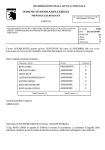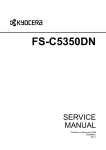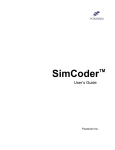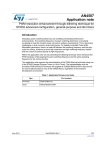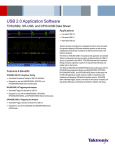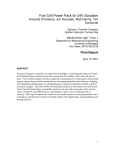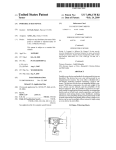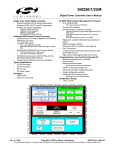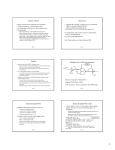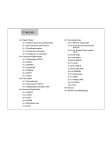Download Digital pulse width modulation techniques for power
Transcript
DIGITAL PULSE WIDTH MODULATION
TECHNIQUES FOR POWER CONVERTERS
by
THANUKAMALAM ARUNACHALAM
A THESIS
Submitted in partial fulfillment of the requirements
for the degree of Master of Science in the
Department of Electrical and Computer
Engineering in the Graduate School of
The University of Alabama
TUSCALOOSA, ALABAMA
2010
Copyright Thanukamalam Arunachalam 2010
ALL RIGHTS RESERVED
ABSTRACT
Recently, digital controls are becoming dominant in almost every power electronic
application because of the advantage when compared to analog control. This includes the ability
of digital controllers to perform more advanced and sophisticated functions that potentially result
in improving power conversion efficiency and/or the dynamic performance of the power
converter, the ease of digital control function and loop upgradeability (or revision), and reduced
sensitivity to component variations. However, there are also some challenges in digital control
such as control loop delays that impact the dynamic performance of the power converters and the
additional controller power consumption in some digital control implementations.
Digital Pulse Width Modulation (DPWM) is one of the most important parts in digital
control systems which control the power switch of the power converters. Modulation technique
plays a vital role in causing control delays. There are several implementation schemes of digital
pulse width modulation such as counter based DPWM, delay line based DPWM, and hybrid
based DPWM. The output voltage is required to have little deviation from the reference voltage
and fast settling times under transient events. Therefore, in order to maintain a well regulated
output voltage, the control signal must instruct the power converter to either turn on (when there
is undershoot in output voltage) or turn off (when there is overshoot in output voltage), as fast as
possible.
ii
The work presented in this thesis suggests a modulation technique that reduces the turn
on delay caused by trailing-edge digital modulation and turn off delay caused by leading-edge
digital modulation. Reducing the digital pulse width modulation delay reduces the overshoot and
undershoot in the output voltage in power converters with digital closed loop control. The
proposed modified digital pulse width modulation scheme is verified using computer simulations
and experimental results.
iii
LIST OF ABBREVIATIONS AND SYMBOLS
PWM
Pulse Width Modulation
APWM
Analog Pulse Width Modulation
DPWM
Digital Pulse Width Modulation
FPGA
Field-Programmable Gate Array
MSB
Most significant bit
LSB
Least significant bit
V
volts: Unit of voltage.
A
amperes: Unit of Current.
µF
micro Farad: Unit of capacitance.
nH
nano Henry: Unit of inductance.
KHz
kilo (103) Hertz. Unit of frequency.
MHz
mega (106) Hertz. Unit of frequency.
<
Less than
>
Greater than
=
Equal to
iv
ACKNOWLEDGMENTS
First and foremost, I would like to express my heartfelt gratitude to committee chairman
and thesis advisor, Dr. Jaber A. Abu Qahouq, who has supported me throughout my thesis with
his patience and knowledge.
I would also like to thank Dr. Tim A. Haskew and Dr. Monica D. Anderson for their
willingness to serve on my thesis committee.
I would like to thank everyone who has helped me throughout my graduate study here at
The University of Alabama.
A special thanks to my friend Vara Prasad Aritkala for helping with experiments.
Finally, I would like to thank my parents, husband and grandmother for their patience,
love and encouragement.
v
CONTENTS
ABSTRACT..........................................................................................................................ii
LIST OF ABBREVIATIONS AND SYMBOLS.................................................................iv
ACKNOWLEDGMENTS.....................................................................................................v
LIST OF FIGURES.............................................................................................................viii
1. INTRODUCTION..............................................................................................................1
1.1 Overview...........................................................................................................................1
1.2 Buck Converters………....................................................................................................2
1.3 Digital Controllers………………………………………………………………….…....5
1.4 Principle of Modulation…………………………….…………........................................7
1.5 Implementation of DPWM …….………………………………………...……….….…..9
1.6 Thesis outline....................................................................................................................18
2. PROPOSED MODIFIED DIGITAL PULSE WIDTH MODUALTION .........................20
2.1 Introduction .......................................................................................................................20
2.2 Voltage deviation during load current transient event.......................................................20
2.3 Effect of DPWM delay on converter’s dynamic response………….……………………21
2.4 Counter based implementation of MDPWM......................................................................23
2.5 Delay line based implementation of MDPWM……………………………….……..……27
3. COMPUTER SIMULATION RESULTS AND COMPARISON……................................30
3.1 Introduction..........................................................................................................................30
3.2 Open loop simulation results………………………………………………...…...…..……30
vi
3.3 Closed loop Simulation model and its components..........................................................33
3.4 Closed loop Simulation results..........................................................................................34
4. EXPERIMENTAL WORK.................................................................................................40
4.1 Introduction........................................................................................................................40
4.2 Experimental setup.............................................................................................................40
4.3 Altera FPGA board overview….........................................................................................42
4.4 Open loop results................................................................................................................43
4.5 Closed loop results…………..............................................................................................48
5. SUMMARY AND FUTURE SCOPE...................................................................................52
REFERENCES..........................................................................................................................55
vii
LIST OF FIGURES
1.1 Schematic of a DC-DC Buck converter controlled by Analog PWM......................................3
1.2 Block diagram of Analog PWM………………………………………………..…..………..4
1.3 Schematic of a DC-DC Buck converter controlled by DPWM................................................4
1.4 Block diagram of DPWM…………………………………………………….………………5
1.5 Outline of Digital controller with switching converter……………………………………….6
1.6 Block diagram of delta modulation……………………………………………………….…..7
1.7 Block diagram of delta-sigma modulation…………………………………...........………….8
1.8 Implementation of counter based DPWM.................................................................................9
1.9 Leading-edge Digital Pulse Width Modulation Scheme………...…………………………..12
1.10 Trailing-edge Digital Pulse Width Modulation Scheme……………………………….…..13
1.11 Dual-edge Digital Pulse Width Modulation Scheme…………………………….…..……..15
1.12 Delay line based Digital Pulse Width Modulation Scheme…………………….…………..16
1.13 Hybrid Digital Pulse Width Modulation Scheme…………………………….……….……18
2.1 Digital control system of Buck converter………………........................................................22
2.2 The Proposed MDPWM (Elimination of turn off delay).........................................................24
2.3 The Proposed MDPWM (Elimination of turn on delay)……………………...………..……26
2.4 Delay line based implementation of MDPWM Scheme………………………………….….28
3.1 Open loop simulation results for conventional DPWM………………………….…………..31
3.2 Open loop simulation results for MDPWM………………………………………………….32
viii
3.3 Closed loop simulation model…………………………...…………………………………..33
3.4 Closed loop Simulation results for Vo=1.5V, ∆i =6A………….……………………………35
3.5 Closed loop Simulation results for Vo=1.5V, ∆i =10A………………………...……………36
3.6 Closed loop Simulation results for Vo=1.5V, ∆i =30A…………………………………...…37
3.7 Closed loop Simulation results for Vo=3.3V, ∆i =6A……………………………………….38
4.1 Schematic Experimental setup…………………………………………………….…………41
4.2 Picture of Altera DE2 board……………………………………………….…………..…….42
4.3 Several switching cycles view during duty cycle step-down from 0.8 to 0.2………….….…44
4.4 Zoomed view during step-down of duty cycle from 0.8 to 0.2……………………….…..….45
4.5 Several switching cycles view during duty cycle step-up from 0.2 to 0.8……………..….....46
4.6 Zoomed view during step-up of duty cycle from 0.2 to 0.8…………………………………47
4.7 Schematic circuit diagram of buck converter…………………………………………..……49
4.8 Closed- loop experimental results……………………………………………..……….…….50
ix
CHAPTER 1
INTRODUCTION
1.1 Overview
Years ago, the linear regulator was used in supplying partial power to devices such as
electric stoves, lamp dimmers, and audio amplifiers, by controlling the amount of current
flowing to a motor. The linear regulator is an electrical component that acts like a variable
resistor. By using a linear regulator much power is wasted in the resistor element, and therefore
this method is inefficient. There are other methods, such as variable auto transformers and Variac
for AC power adjustment. These methods are relatively efficient but have high cost. There was a
need for a scheme that efficiently delivers partial power to devices [1-15, 31,40].
Pulse Width Modulation (PWM) is a scheme that provides an intermediate amount of
electric power between fully on and fully off. PWM circuits output a square waveform with a
varying on to off ratio. The average ratio can vary from 0 to 100 percent. This on time (TON) to
off time period (T) ratio is called as duty cycle, which is expressed in percentage. Therefore, by
this scheme, a variable amount of power is transferred to the load. The main advantage of PWM
over the linear regulator is its efficiency. For example, at 50% level PWM will use 50% of
power, that is almost transferred to load but on the other hand in linear regulator control scheme
50% of load power consumes 71% of full power where 50% of power goes to the load and the
remaining 21% is dissipated as heat[1-15, 31,40].
1
The main applications of PWM are in power converters, audio amplifiers, and controlling
the speed of motors. The output of the PWM is generally a fixed pulse frequency that is on and
off for fixed period of time. PWM works well with digital control because of the on and off
nature.
Digital controls are increasingly used in power converters because of their advantage
when compared to analog controls. The main advantages of using digital controls over analog are
the ability to perform more advanced and sophisticated functions that potentially result in
improving power conversion efficiency and/or dynamic performance of the power converter, the
ease of digital control function and loop upgradeability, and reduced sensitivity to component
variations compared to analog controllers [1-12, 23-26, 30, 31, 33].
Digital controllers are discussed more in a later section. The next section discusses the
operation of DC-DC buck converters and the associated control techniques.
1.2 Buck Converters
The DC-DC buck converter, or step down DC-DC converter, is used to step down the
DC input voltage. They are used in applications such as powering small devices like cell phones
to bigger and more power consuming servers.
The DC-DC buck converter circuit basically consists of two switches, an inductor, and
capacitors. The operation of DC-DC buck converter is simple. The two switches control the
inductor. When the switch is on, it connects the inductor to the source voltage, to store energy.
When the switch is off it discharges energy to the load. The timing of the switch operations are
determined by the PWM control signal. The controller can be either an analog controller or
digital controller. The analog controllers are simple, low cost, and well established designs, but
digital controllers are widely used.
2
The advantages of digital controllers are mentioned in section 1.1[1-12, 23-26, 30, 31,
33]. A simple schematic circuit of a buck converter controlled by an analog PWM is shown in
Figure 1.1.
Figure 1.1: Schematic of a DC-DC Buck converter controlled by Analog PWM
Buck converters controlled by analog pulse width modulation (APWM) operate as
follows. The compensator outputs an analog signal called the error signal. The carrier signal is a
ramp (saw-tooth) that has a linear relationship between input signal and output pulse width
signal. The error signal is compared with the carrier signal to provide amplitude to time domain
conversion [1,2]. A block diagram of analog PWM is shown in Figure 1.2. The PWM is set high
at the starting of switching frequency (Fsw) and resets when there is any difference between
carrier waveform generator and control voltage [2].
3
Figure 1.2: Block diagram of Analog PWM
A simple schematic circuit of the DC-DC Buck converter controlled by DPWM is shown
in Figure 1.3. The analog to digital converter (ADC) is used to convert the analog voltage value
to a digital value. The resolution of the DPWM depends on the number of ADC bits. The digital
value is compensated and compared with the reference value which gives the duty cycle.
Figure 1.3: Schematic of a DC-DC Buck converter controlled by DPWM
4
Digital pulse width modulation (DPWM) provides a digital to time domain conversion.
The time is quantized into number of discrete slots and is selected by a digital input d[n] instead
of a carrier ramp signal. The duty cycle is compared with the time slots in order to generate the
DPWM signal [2]. According to [2], the block diagram of digital PWM is shown in Figure 1.4.
Figure 1.4: Block diagram of DPWM
1.3 Digital Controllers
A digital controller for switching mode power supplies (SMPS) is one of the fields that
have attracted great research attention [1-14, 18, 30, 32, 33, 34]. According to [30], the reason
for digital control becoming more popular in power electronics is its advantages over analog
control, such as immunity to component variations and the ability to implement functions that
improve the whole system performance. The digital controller consists mainly of three
components. They are the analog to digital converter (ADC), digital compensation unit, and
digital pulse width modulation (DPWM) unit. In Figure 1.5 the outline of a digital controller
with switching converter is shown.
5
+
Vin
+
Vout
SWITCHING CONVERTER
LOAD
-
Digital Pulse Width
Modulator
Digital Compensation
Unit
ADC
Vref
Figure 1.5: Outline of Digital Controller with switching converter.
According to [30] the digital controllers developed till now are the conventional
architecture. In the conventional architecture, ADCs are used to digitize the converter state
variables. The digital compensator unit determines the duty cycle, but this approach does not
match the dynamic performance of the analog counterparts. The drawbacks of this architecture
are delay in sampling or processing and limited resolution [18].
According to [30] development of alternative digital control architecture is needed that
potentially enables a simple control architecture and faster dynamic performance. Analysis of
[30, 32, 33, 34] suggests that the switching instants are determined by the combinations of
system clock and intersection of controlled state variable and digitally controlled voltage and
current ramps. In [32], two digital to analog converters (DAC) are used to control the analog
peak mode modulator and the voltage mode modulator. In [30, 33], a similar principle is used,
but it is applied to voltage-mode control of the synchronous buck converter. According to [30],
6
the main drawback in [33] is limit cycle oscillation when the equivalent series resistance (ESR)
of the output capacitor is small. Analysis of [30] proposes a mixed signal, fixed frequency
voltage mode controller for dc-dc converters where the derivative part of PID regulator is
maintained in the analog domain. In this proposed controller the switch on is determined by the
system clock and switch off is determined by comparing converter output voltage and
instantaneous output voltage [30].
1.4 Principle of modulation
The pulse width modulation technique uses a rectangular wave whose pulse width can be
modulated resulting in an average value waveform. This modulation can be done in different
ways such as delta, delta-sigma, and digital, which are discussed below.
Vref
Ve
+
LIMITER
SAMPLER
DELTA
MODULATED
SIGNAL
-
Vc
∫
INTEGRATOR
Figure 1.6: Block diagram of delta modulation.
The block diagram of delta modulation is shown in Figure 1.6. Delta modulation
technique is known for its high stability and rapid response [35]. The delta modulation controller
is relatively easy to implement when compared with other modulation controller techniques. The
operation of delta modulation technique as follows. The carrier signals are obtained by
integrating the output modulated signal. The control signal (Vref) is compared with the carrier
signal (Vc) and outputs the error signal (Ve). The error signal is quantized to produce the delta
7
modulated signal [35].The analysis of [35] suggests that this controller cannot be applied to the
DC-DC converter because of equal rising and falling edge of the carrier signal. In order to
overcome this drawback, delta-sigma modulation was proposed.
∫
∫
Figure 1.7: Block diagram of delta-sigma modulation.
The block diagram of delta-sigma modulation is shown in Figure 1.7. In delta-sigma
modulation the control signal (Vref) is fed forward to an integrator. In this way the slope of the
integrator can be adjusted. Because of this feed forward signal, the positive and negative slope of
the carrier signal is obtained. The rest of the operation is similar to the delta modulation. The
delta-sigma modulation technique is widely used in data conversions and to achieve high
resolution [36].
Digital modulation can be implemented in various ways such as counter based, delay line
based and hybrid DPWM. Section 1.6 discusses in detail the various implementation of DPWM.
This work mainly focuses on the digital pulse width modulation technique [1, 2, 14, 16, 20, 22].
8
1.5 Implementation of DPWM
This section discusses the various methods of implementing digital pulse width
modulation, such as counter based, delay line based, and hybrid. This section also discusses
some common modulator techniques. The three common modulators are leading edge, trailing
edge, and double edge modulation. The next section discusses the operation and delay caused by
digital pulse width modulators [1, 2, 14, 16].
1.5.1
Counter- based Digital Pulse Width Modulation
This section describes the basic operation of PWM when implemented in the digital
domain using a counter. In analog PWM, the error signal is compared with ramp, and PWM
pulses are generated. In digital PWM the duty cycle is compared with the counter value, and the
DPWM signal is generated. A 10 bit duty cycle will be in the range of 0 to 1023. The
transformation of analog to digital is performed by converting the error signal to duty cycle using
an ADC. The ramp signal is generated using a counter. The resolutions of DPWM are finite
when compared to the APWM. In other words, DPWM has better output regulation and less or
no limit cycle oscillations. Counter based DPWM has modulation delays. These delays occur
when there is a change in duty cycle [1, 2, 8, 12, 14, 16-18, 20, 22]. Counter based DPWM is
implemented using counters as shown in Figure 1.8.
Figure 1.8: Implementation of counter based DPWM
9
The counter can be either up counter, down counter, or an up-down counter, depending
on the modulation scheme. When the counter counts down, then it depicts the leading edge
modulator. When the counter counts up, then it depicts the trailing edge modulator. When the
counter counts up and down, then it depicts the dual edge modulator. The input clock frequency
(Fclk) of the counter is directly proportional to switching frequency (Fsw) and number of bits (n).
According to [1, 2, 12, 16] the relationship can be expressed as follows.
Fclk = Fsw * 2n
(1.1)
If the counter is 10 bit counter with the clock frequency of 350 MHz then the switching
frequency would be 342 KHz. The main advantages of the counter based DPWM are its
simplicity and linearity. In order to achieve high resolution the number of bits in the counter
should be high.
The main disadvantage of counter based is need for high clock frequency and high power
consumptions [1, 2, 12, 29]. For example a 10 bit DPWM with switching frequency 1 MHz, the
required clock frequency will be approximately 1 GHz, and also power consumption will be
high. Therefore implementation of high frequency, high resolution counter based DPWM would
be a difficult [2, 12, 14, 16, 20]. The three common modulators implemented using counter based
technique is discussed below.
a. Leading-edge Digital Pulse Width Modulation
The leading-edge DPWM block diagram and its operational waveform are shown in
Figure 1.9. The duty cycle and counter are inputs to a comparator. The counter is a down
counter. The output of the comparator turns the DPWM pulse on whenever the duty cycle is
higher than the counter value. DPWM will be turned off only at the end of switching cycle. The
S-R flip flop sets the DPWM high when the duty cycle is greater than counter value and it resets
when the main counter finishes counting to zero.
10
Under the transient load condition at point t3 as shown in Figure 1.9(b) the duty cycle
drops below the counter but the modulator cannot respond to the change, it waits until the end of
the switching cycle, to turn off the DPWM. This turn off delay results in overcharging the
inductor. Therefore inductor delivers more power to output and cause extra overshoot or ring
back in output voltage. Therefore, this conventional leading-edge modulation has delay in
turning off the DPWM [2, 14, 16, 20].
11
fsw
fclk
Counter
Comparator
S
SET
Q
DPWM
Duty Cycle
Zero State
Detector
R
CLR
Q
(a)
(b)
Figure 1.9: Leading-edge Digital Pulse Width Modulation
(a) Block diagram and (b) Operational waveform
12
b. Trailing-edge Digital Pulse Width Modulation
(a)
(b)
Figure 1.10: Trailing-edge Digital Pulse Width Modulation
(a) Block diagram and (b) Operational waveform
13
Trailing-edge DPWM block diagram and its operational waveforms are shown in Figure
1.10. In trailing-edge modulation, the DPWM is turned on by the clock signal and is turned off
by output of the comparator. The inputs to the comparator are similar to leading edge
modulation. But here, the counter is an up counter. In this scheme, turning on the DPWM pulse
is fixed, and turning off the pulse is done by output of the comparator. Therefore, initially at the
starting of switching cycle, the DPWM is turned on, and if the duty cycle value goes below the
counter, the comparator the DPWM is turned off. In this case after the DPWM is switched off by
comparator and if the duty cycle goes high in the same switching cycle, then modulator will not
respond to the change it waits until the next switching cycle. At point t1 as shown in Figure 1.10
(b) the duty cycle goes above the counter but the modulator cannot respond to the change, it
waits until the end of the switching cycle, to turn on the DPWM. Therefore this causes a turn on
delay [2, 14, 16, 20].
c. Dual-edge Digital Pulse Width Modulation Scheme
The block diagram of dual-edge DPWM and its operational waveform are shown in
Figure1.11. The counter in this conventional scheme is an up\down counter. In the first half of
the switching cycle the counter acts as either up or down and in the second half of the cycle it
acts either down or up, or vice versa. When the counter value is greater than duty cycle, then the
DPWM pulse is set to high. Half of the switching cycle act as leading edge and other half of the
switching cycle act as trailing edge.
Therefore, in this case turn on and turn off delay times exist and are shorter when
compared to the leading edge and trailing edge modulator [2, 14, 16, 20].
14
(a)
(b)
Figure 1.11: Dual-edge Digital Pulse Width Modulation Scheme
(a) Block diagram and (b) Operational waveform
1.5.2
Delay line based Digital Pulse Width Modulation
The block diagram of delay line based DPWM is shown in Figure1.12. . This type of
modulation employs delay cells connected in cascade.
15
(a)
(b)
Figure 1.12: Delay line based Digital Pulse Width Modulation Scheme
(a) Trailing-edge delay line DPWM (b) Leading-edge delay line DPWM
The pulse width is quantized as a function of delay cells. For an ‘n’ bit duty cycle, 2n
delay elements are used. The selection of the delay cells is made by the multiplexer. The
multiplexer is selected in such a way that for ‘n’ bit duty cycle, 2n :1 multiplexer is used.
Therefore, the control signal for the multiplexer is also ‘n’ bit. The value of these ‘n’ bits control
signal is the duty cycle value. Selection of the delay cells are performed by the multiplexer’s
16
control signal. Part (a) of Figure 1.12 shows the trailing edge delay line based DPWM. The
DPWM is set by clock and the reset action is done by the delay elements. In this case turning off
the DPWM is fixed. When there is more than one change in the duty cycle value the DPWM
cannot respond to the change and it waits until the next switching cycle to turn on the DPWM.
Therefore there exists the turn on delay.
Part (b) of Figure 1.12 shows the leading edge delay line based DPWM. The DPWM is
set by the delay elements, and the reset action is performed by the clock. In this case, turning on
the DPWM is fixed. When there is more than one change in the duty cycle value, the DPWM
cannot respond to the change, and it waits until the next switching cycle to turn off the DPWM.
Therefore there exists the turn off delay. When the DPWM The disadvantage of this modulation
is due to semiconductor material properties there will be variation in process and temperature
that causes the variation in cell delay. The other disadvantage of delay line based DPWM is, it
occupies large area [2, 12].
1.5.3
Hybrid Digital Pulse Width Modulation
Hybrid digital pulse width modulation is the combination of counter based and delay line
based modulation. The hybrid digital pulse width modulation scheme provides high resolution,
high frequency DPWM when compared to counter based and occupies less area when compared
to delay line modulation. For example, a 5 bit hybrid DPWM can be broken down as a three bit
counter DPWM and two bit delay line based DPWM. Therefore by this combination the need for
high clock frequency, variation due to process, temperature and large area will be eliminated.
Counter based DPWM controls the most significant bit (MSB) of the duty cycle while the delay
line based controls the least significant bit (LSB) of the duty cycle or it can also be vice versa.
17
COMPARATOR
clk
COUNTER
(m bit)
2n Delay
Eements
=
msb (Duty)
MULTIPLEXER (2n:1)
lsb (Duty )
PWM
Fsw
Figure 1.13: Block diagram of Hybrid Digital Pulse Width Modulation
For example in a 5 bit hybrid DPWM, 3 bit (m=3) counter counts from 000 to 111. And
there are 4 delay elements with 4:1 multiplexer to select the delay cells. The 2 LSBs of the duty
cycle are used as multiplexer control signal (n=2). The counter counts at each clock period.
Initially the DPWM is set at the counter value of zero and the output of the counter is compared
with MSBs of the duty cycle. When the counter reaches the duty cycle value it sends a signal for
the delay line based DPWM. And the LSBs of the duty cycle will select the delay elements and
sends a reset signal to the DPWM [12, 29]. The block diagram of hybrid DPWM is shown in
Figure 1.13.
1.6 Thesis outline
As mentioned in earlier sections 1.6.1.a. and 1.6.1.b., during a transient event, there exists
a modulation delay that can decrease performance of the buck converter. Therefore, a new
modulation scheme is proposed to achieve fast response during transient event. The next chapter
discusses in detail about proposed Modified Digital Pulse Width Modulation (MDPWM) and its
implementation. Chapter 3 presents simulation results obtained using MATLAB\Simulink®.
18
The experimental set-up and the results are presented in Chapter 4 followed by the
summary and future work in chapter 5.
19
CHAPTER 2
PROPOSED MODIFIED DIGITAL PULSE WIDTH MODUALATION
2.1 Introduction
Under a load step up current transient, there is an undershoot in the output voltage.
Undershoot in the output voltage requires an increase in duty cycle to maintain a regulated
output voltage, which increases the on time of the modulator. Under load step down current
transient there is an overshoot in the output voltage. Overshoot in output voltage demands a
decrease in duty cycle to maintain a regulated output voltage, which decreases the on time of the
modulator [1, 2, 12, 14, 16].
In the conventional digital pulse width modulation schemes, the leading edge digital
pulse width modulation exhibits turn off delay while the trailing edge digital pulse width
modulation exhibits turn on delay. Therefore, a new modulation technique is proposed to reduce
such delays. The main motivation behind reducing this delay is discussed in section 2.2,
followed by discussion on the effect of these digital pulse modulation delays on the power
converter in section 2.3, and in the later section the details and implementation of proposed
MDPWM are presented.
2.2 Voltage deviation during load current transient events
Present integrated circuits (ICs) having high clock frequencies are accompanied by
associated increases in the demand for power and fast transient response [16, 17, 19, 20].
20
Positive deviation from the nominal output voltage is called overshoot, and negative
deviation from the nominal output voltage is called undershoot. The voltage deviation must be
reduced in order to meet the load dynamic requirements. In order to maintain well regulated
output voltage, the control signal must instruct the DPWM either to turn on or off early. If there
is delay in the DPWM, then this may cause output voltage deviation.
Under load current transient events when the load increases or decreases, the control
signal increases or decreases the on time of the DPWM signal to maintain a regulated output
voltage. In most of the current applications, the transient response will be completed in one
switching cycle. Conventional modulation may not respond to a change in the duty cycle in the
same switching cycle [1-5, 14, 16, 19, 21].
The proposed modified digital pulse width
modulation discussed in this chapter reduces the digital modulation delay of the conventional
DPWM.
2.3 Effect of DPWM delay on converter’s dynamic response
The purpose of the delay analysis is to improve the design of the converter and also to
facilitate the design of the output capacitor. At load current transients, the delay caused by the
DPWM, which is discussed in earlier sections, cannot be controlled by the capacitor design [14].
According to [25], the duty cycle resolution of counter based DPWM can be determined by
(2.1):
∆D = f sw /f
clock
(2.1)
Where ∆ D is duty cycle resolution, fsw is switching frequency and fclock is clock
frequency. According to [25], the relationship between the duty cycle resolution and output
voltage resolution for a DC-DC buck converter is determined by (2.2):
21
∆V
o
= V in * ∆D
(2.2)
∆ Vo is the output voltage resolution, and Vin is the input voltage. In the leading edge
modulation scheme, under load current transient events, there exists a turn on delay. The worst
case of this time delay occurs when there is a change in duty cycle value, at the starting of the
switching cycle. According to [14] this maximum delay ( td) can be expressed in terms of duty
cycle (2.3):
td = Tsw * (1 - D + D/2)
(2.3)
Where the switching time is Tsw = 1\ fsw . According to [1] the digital control system of
buck converter is shown in Figure 2.1.
Figure 2.1: Digital control system of buck converter [1].
The open loop transfer function is
Vo
= D ( Z ) * Z {K dpwm ( s ) * G D ( s )}
Vref
22
(2.4)
The closed-loop control to output transfer function is
C (Z ) =
D ( Z ) * Z { K dpwm ( s ) * G D ( s )}
1 + D ( Z ) * Z { K dpwm ( s ) * G D ( s ) K a / d ( s )}
(2.5)
The transfer function of the DPWM is determined by (2.6)
Kdpwm (s) = Kdpwm * e-( sTdpwm)
(2.6)
Kdpwm = 1 / {(2n dpwm ) – 1 } for 10 bit DPWM equal to Kdpwm = 1 / 1023, and Tdpwm is
the delay between the time the DPWM input is updated and the time the switch duty ratio
changes[1]. The transfer function of the converter depends on the transfer function of DPWM,
controller and ADC. Therefore modulation delay affects the transfer function of the converter.
2.4 Counter based implementation of MDPWM
The basic concept of the proposed MDPWM scheme is the addition of the auxiliary
counter in order to reduce the delay discussed in section 1.5. Figure 2.2 shows the reduction of
turn off delay caused by the conventional leading-edge digital pulse width modulation.
The operation of MDPWM (to reduce the turn off delay) is as follows. The main counter
is a down counter as it is the case in the leading-edge DPWM, and the auxiliary counter is an up
counter. The auxiliary counter starts to count when the DPWM signal is set to high. At t1, the
DPWM signal is high and the auxiliary counter starts to count up until it reaches the duty cycle.
In the conventional leading-edge modulation scheme the DPWM signal cannot be turned off any
time after the DPWM signal is set to high. It can be turned off only when the main counter
finishes counting. In contrary the proposed auxiliary counter can turn off any time with reduce
turn off modulation delay.
23
(a)
(b)
Figure 2.2: The Proposed MDPWM (Reduction of turn off delay)
(a) Block diagram and (b) Operational waveform
24
At t3, the duty cycle drops from high to low, and the proposed modulator senses the
change and resets the DPWM. It does not wait until the end of switching cycle to reset the
DPWM. Therefore, in the proposed DPWM the turn off delay is reduced. This operation results
in improvement in the output voltage overshoot. Figure 2.3 shows the reduction of turn on delay
caused by the conventional trailing edge digital pulse width modulation.
The operation of MDPWM (to reduce the turn on delay) is as follows. The main
counter is an up counter as it is the case in the trailing-edge DPWM and auxiliary counter is a
down counter. The auxiliary counter starts to count when the DPWM signal is set to low. At t3,
the DPWM signal is low and the auxiliary counter starts to count up until it reaches the duty
cycle. In the conventional modulation scheme the DPWM signal cannot be turned on any time
after the DPWM signal is set to low. It can be turned on only when the main counter finishes
counting. In contrast, the proposed auxiliary counter can turn on any time with reduce turn on
modulation delay. At t1 the duty cycle increases from low to high value and the proposed
modulator senses the change and sets the DPWM. It does not wait until the end of switching
cycle to set the DPWM. Therefore in the proposed DPWM the turn on delay is reduced. This
operation results in improvement in the output voltage undershoot.
25
(a)
(b)
Figure 2.3: The Proposed MDPWM (Reduction of turn on delay)
(a) Block diagram and (b) Operational waveform
26
The proposed Modified Digital Pulse Width Modulation (MDPWM) scheme reduces the
modulation delays that occur under load current transient conditions. Reduced modulation delay
means reduced output voltage deviation from the reference voltage. The concept of the proposed
MDPWM is to reduce the modulation delay by adding an auxiliary counter that helps either to
turn on or turn off the control signal. In conventional DPWM techniques, there is either turn on
or turn off delay, therefore, by adding an auxiliary counter to the modulation helps to reduce the
delay.
2.5 Delay line based implementation of MDPWM
This section discusses the other possible implementation of proposed MDPWM. The
proposed modulation scheme can also be implemented using delay line based DPWM. In the
delay line based DPWM the number of delay cells depends on the number of bits of the DPWM.
In conventional delay line based DPWM the pulse is set by the delay elements and the clock
resets the DPWM. In the proposed MDPWM additional delay elements are added to reset the
DPWM. Here the control signal for the multiplexer will be (1 - duty cycle). The implementation
of MDPWM in using delay line to reduce turn off delay is shown in part (a) of Figure 2.4.
27
(a)
(b)
Figure 2.4: Delay line based implementation of MDPWM Scheme
(a) Reduction of turn off delay (b) Reduction of turn on delay
28
The DPWM pulse is set by the delay elements. The reset action is done by either a clock
or the auxiliary delay elements. The auxiliary delay element resets the DPWM when ever there is
more than one change in duty cycle, in one switching cycle. The implementation of MDPWM
using delay line to reduce turn on delay is shown in part (b) of Figure 2.4. The DPWM pulse is
reset by the delay elements. The set action is done by either a clock or the auxiliary delay
elements. The auxiliary delay element sets the DPWM when ever there is more than one change
in duty cycle, in one switching cycle.
The addition of auxiliary delay elements requires large area. The main disadvantages of
the delay line based DPWM compared to the counter based implementation are possible nonlinearity and large area. More investigation in this delay line based MDPWM is planned to be
carried out in the future.
29
CHAPTER 3
COMPUTER SIMULATION RESULTS AND COMPARISION
3.1 Introduction
The computer software simulation results of the conventional DPWM and proposed
MDPWM are presented in this chapter. The simulation results are obtained using
Matlab®/Simulink® and PLECS® software. The open loop simulation were performed first, in
order to verify the operation of the proposed MDPWM, and then followed by closed loop
simulation results. The open loop simulation results are presented in Section 3.2, and the closed
loop simulation results are presented in Section 3.3 and 3.4.
3.2 Open loop simulation results
In this section, the open loop simulation results of the conventional leading edge DPWM
and proposed MDPWM are presented. In open loop simulations, the duty cycle is varied using a
counter that switches between two constant values for a fixed time. This simulates the duty cycle
that will be provided by the closed loop controller.
The open loop simulation is performed by a counter based 10 bit DPWM using 350 MHz
clock. The switching frequency is calculated as 342 KHz using equation 1.1. The main counter is
a down counter which resembles leading edge modulation. In this open loop simulation, the duty
cycle is varied from 0.68 to 0.1.
30
COUNTS
Counter
VOLTAGE (Volts)
Duty Cycle
Modulation Delay
TIME (sec)
Figure 3.1: Open loop simulation results for conventional leading edge DPWM
Figure 3.1 presents the open loop results for the conventional leading edge DPWM. As
shown in Figure1.9, when the duty cycle is higher than the counter value, the DPWM is set high
by the comparator, and the DPWM signal resets when the counter value reach zero.
If there is any change in the duty cycle, it will not respond until next switching cycle. At
0.228 microseconds, there is a change in duty cycle, but the DPWM does not respond to the
change and waits until the next switching cycle to turn off the DPWM. Therefore, turn off delay
exists, which affects the dynamic performance of the closed loop system.
31
Duty Cycle
VOLTAGE (Volts)
COUNTS
COUNTS
Counter
Reduced Modulation Delay
TIME (sec)
Figure 3.2: Open loop simulation results for MDPWM
Figure 3.2 presents the open loop results for the MDPWM. In the proposed modulation
scheme, the auxiliary counter is added as shown in Figure 2.2 to reset the MDPWM when there
is any change in the duty cycle value as discussed in chapter 2. The auxiliary counter starts to
count when the MDPWM is set to high and it counts till the end of switching cycle as shown in
Figure 3.2. When the duty cycle value goes below the counter in the middle of the cycle then the
auxiliary counter resets the MDPWM. At 0.228 microseconds, the duty cycle is changed from
0.68 to 0.1 and the auxiliary counter resets the MDPWM. Therefore, the proposed modulation
scheme responds to change in the duty cycle and reduces the turn off delay in this case.
32
3.3 Closed loop simulation model and its components
The specifications of the DC-DC buck power converter used for the closed-loop
simulation of conventional and proposed MDPWM are the same. The specification of the DCDC buck converter is as follows: Vin = 8V, Vo= 1.5V/ 3.3V, L= 440nH, C= 350µF, Fsw ~ 342
KHz, Fclock = 350 MHz, n ADC = 10 bits to sample output voltage.
Output Voltage and Load Transient
Gate2
NOT
Gate21
PLECS
Circuit
Load
Pulse
Generator
Output Voltage
Iin
Vo
Load Transient
Iout
Buck Converter
Output Voltage
DPWM Signal
Duty Cycle
Duty Cycle
Reference Voltage
3.3
Vref
DPWM Circuit
Digital Compensator with 10 Bit ADC
Figure 3.3: Closed-loop simulation model
33
The simulation model has three main components: the DC-DC buck converter circuit, a
digital compensator with 10 bit ADC, and a digital modulation unit. The PLECS® toolbox is
used to build the buck converter. The input of the buck converter is 8 Volts. The simulation
model of the closed- loop buck converter is shown in Figure 3.3. The simulation results are
obtained for two reference voltages of 1.5 Volts and 3.3 Volts.
3.4 Closed- loop simulation results
The closed- loop simulation results of conventional and proposed MDPWM are presented
in this section. The buck converter, with 8V input and 1.5 V output, are used in the simulation.
The load step current transients are made when the DPWM is on to check whether the turn off
delay is reduced. Load step current transient ( ∆ i) of 6A, 15A, and 30A are applied as shown in
figures 3.4, 3.5, 3.6. Part (a) of these figures shows the comparison between the conventional and
the proposed DPWM signal during load current transient event. And part (b) of these figures
shows the comparison between the conventional and the proposed DPWM output voltage signal.
From part (a) figures, it is observed that at current transient events the proposed MDPWM signal
has been turned off early when compared to the conventional DPWM. The turn off delay is
reduced in proposed MDPWM. From part (b) figures it is observed that because of reducing the
turn off delay using the proposed MDPWM there is an improvement (reduction) in output
voltage overshoot. Therefore it is observed from the figures 3.4, 3.5, 3.6 that during the load step
down current transients the conventional leading-edge modulator has a significant turn off delay
while the proposed modulator has reduced turn off delay. Therefore, the proposed MDPWM has
reduced turn off delays, unlike conventional DPWM modulators, leading to dynamic response
improvement.
34
VOLTAGE (Volts)
Conventional DPWM
MDPWM
LOAD CURRENT (A)
LOAD CURRENT TRANSIENT
TIME (sec)
(a)
VOLTAGE (Volts)
Conventional DPWM
MDPWM
LOAD CURRENT (A)
LOAD CURRENT TRANSIENT
TIME (sec)
(b)
Figure 3.4: Closed loop simulation results for Vo=1.5V, ∆ i=6A (a) Load current transient
during on time (b) Output voltage during load current transient
35
LOAD CURRENT (A)
VOLTAGE (Volts)
Conventional DPWM
MDPWM
LOAD CURRENT TRANSIENT
TIME (sec)
LOAD CURRENT (A)
VOLTAGE (Volts)
(a)
Conventional DPWM
MDPWM
LOAD CURRENT TRANSIENT
TIME (sec)
(b)
Figure 3.5: Closed loop simulation results for Vo=1.5V, ∆ i=10A (a)Load current transient
during on time (b) Output voltage during load current transient
36
VOLTAGE (Volts)
Conventional DPWM
MDPWM
LOAD CURRENT (A)
LOAD CURRENT TRANSIENT
TIME (sec)
LOAD CURRENT (A)
VOLTAGE (Volts)
(a)
Conventional DPWM
MDPWM
LOAD CURRENT TRANSIENT
TIME (sec)
(b)
Figure 3.6: Closed loop simulation results for Vo=1.5V, ∆ i=30A (a) Load current transient
during on time (b) Output voltage during load current transient
37
VOLTAGE (Volts)
LOAD CURRENT (A)
Conventional DPWM
MDPWM
LOAD CURRENT TRANSIENT
TIME (sec)
(a)
VOLTAGE (Volts)
Conventional DPWM
MDPWM
LOAD CURRENT (A)
LOAD CURRENT TRANSIENT
TIME (sec)
(b)
Figure 3.7: Closed loop simulation results for Vo=3.3V, ∆ i=6A (a) Load current transient
during on time (b) Output voltage during load current transient
38
From the simulation results presented in this chapter, the turn off delay is reduced by the
proposed MDPWM, and improvement in overshoot voltage is achieved. In the next chapter the
experimental results are presented and discussed.
39
Chapter 4
EXPERIMENTAL WORK AND RESULTS
4.1 Introduction
This chapter presents the experimental set up and the results obtained for the
conventional DPWM and the proposed MDPWM. The open loop results are obtained as
discussed in the Chapter 3. In closed loop control of the power converter, the compensator
calculates the value of duty cycle and provided to the modulator. The experimental set up is
discussed in Section 4.2, followed by overview of Altera FPGA board used in the experiment,
and then the open loop and closed- loop experimental results are presented
4.2 Experimental set-up
The experimental set up is illustrated in Figure 4.1. The following components are used
for the experiment:
•
Digitally controlled Single phase DC-DC Buck power converter.
•
Altera DE 2 board.
•
USB cable for FPGA programming and control.
•
9V DC wall mount power supply.
•
DC Load: Chroma 6312.
•
Chroma Programmable DC power Supply: 6201P-80-60.
•
Tenma Laboratory DC power Supply 72-6615.
40
•
Oscilloscope: Tektronix DPO7104.
•
Connectors.
Figure 4.1: Schematic Experimental setup
An Altera Cyclone II EP2C35F672C6 chip is used to provide the closed loop control for
the power converter. On the DE2 board, there is a built in 50 MHz clock. The main clock of 350
MHz is needed for the counter, and it is generated using a phase lock loop (PLL). The Quartus
mega wizard built in PLL function is used to generate a 350 MHz clock. The program is written
in verilog and downloaded to the DE2 board via USB programming cable. The buck converter is
connected to the DE2 board via connectors. The input voltage is provided to the buck converter
using Chroma Programmable DC power Supply. Chroma 6312 DC load is used as the output
current load to the power converter.
41
4.3 An overview of Altera FPGA board
The Altera DE2 board has cyclone II 2C35 FPGA chip with 3500 logic elements, 475
user IOs, 35 embedded multipliers and 4 PLLs. It also includes a 50MHz clock, 27 MHz clock,
and Sub-Multi Assembly (SMA) and external clock input [41]. An example picture of Altera
DE2 board is shown in Figure 4.2 [39].
Figure 4.2: Picture of Altera DE2 board
The resources used from the FPGA board include:
•
50 MHZ clock source
•
Expansion header
•
Phase lock loop (PLLs)
•
Switches
•
Other circuitry
42
Quartus is the software that supports the Altera DE2 board. The program is written in
hardware descriptive language (HDL) and is compiled. At the end of compilation process, the
quartus creates a SRAM (Static Random Access Memory) object file (SOF). This SOF file is
downloaded to the DE2 board via joint test action group (JTAG) programming mode [39].
4.4 Open loop results
The open loop experiments are conducted by providing a duty cycle that switches
between two constant values. The duty cycle transients occur in the FPGA, using a counter that
switches between two constant values periodically. The open loop experiment does not have a
compensator. The main reason for performing the open loop experiments is to verify the
operation of the proposed modified digital pulse width modulation. The program is written in
verilog and downloaded to the Altera FPGA board. The waveforms are recorded using Tektronix
DPO7104 oscilloscope. Figure 4.3 and 4.4 shows the reduction of turn off delay while Figure
4.5 and 4.6 shows the reduction of turn on delay. In Figure 4.3 and 4.4, part (a) is the
conventional leading-edge DPWM and part (b) is the proposed MDPWM. In each figure, the top
trace is the DPWM or MDPWM output of the modulator and the bottom trace represents an
indication of the duty cycle change/transient from 0.8 to 0.2 and vice versa (logic high for 0.8
and logic low for 0.2).
Figure 4.3 shows a zoom out view of several switching cycle during duty cycle step down
of 0.8 to 0.2 for both conventional leading edge and MDPWM. It can be observed that the
conventional leading edge and proposed digital pulse modulator have no turn on delay.
43
D = 0.8
D = 0.2
Horizontal axis: time, scale: 5µs/div.
Vertical axis: voltage, top trace: DPWM, scale: 1V/div.,
bottom trace: Duty Cycle Change Indication Signal, scale: 2V/div.
(a)
D = 0.8
D = 0.2
Horizontal axis: time, scale: 5µs/div.
Vertical axis: voltage, top trace: DPWM, scale: 1V/div.,
bottom trace: Duty Cycle Change Indication Signal, scale: 2V/div.
(b)
Figure 4.3: Several switching cycles view during duty cycle step-down from 0.8 to 0.2:
(a)Conventional leading-edge DPWM (b) Proposed MDPWM.
44
D = 0.8
D = 0.2
Horizontal axis: time, scale: 2µs/div.
Vertical axis: voltage, top trace: DPWM, scale: 1V/div.,
bottom trace: Duty Cycle Change Indication Signal, scale: 2V/div.
(a)
D = 0.8
D = 0.2
Horizontal axis: time, scale: 2µs/div.
Vertical axis: voltage, top trace: DPWM, scale: 1V/div.,
bottom trace: Duty Cycle Change Indication Signal, scale: 2V/div.
(b)
Figure 4.4: Zoomed view during step-down of duty cycle from 0.8 to 0.2. (a) Conventional
leading-edge DPWM (b) Proposed MDPWM.
45
D = 0.8
D = 0.2
Horizontal axis: time, scale: 5µs/div.
Vertical axis: voltage, top trace: DPWM, scale: 1V/div.,
bottom trace: Duty Cycle Change Indication Signal, scale: 2V/div.
(a)
D = 0.8
D = 0.2
Horizontal axis: time, scale: 5µs/div.
Vertical axis: voltage, top trace: DPWM, scale: 1V/div.,
bottom trace: Duty Cycle Change Indication Signal, scale: 2V/div.
(b)
Figure 4.5: Several switching cycles view during duty cycle step-up from 0.2 to 0.8.
(a) Conventional trailing-edge DPWM (b) Proposed MDPWM.
46
D = 0.8
D = 0.2
Horizontal axis: time, scale: 2µs/div.
Vertical axis: voltage, top trace: DPWM, scale: 1V/div.,
bottom trace: Duty Cycle Change Indication Signal, scale: 2V/div.
(a)
D = 0.8
D = 0.2
Horizontal axis: time, scale: 2µs/div.
Vertical axis: voltage, top trace: DPWM, scale: 1V/div.,
bottom trace: Duty Cycle Change Indication Signal, scale: 2V/div.
(b)
Figure 4.6: Zoomed view during step-up of duty cycle from 0.2 to 0.8.
(a) Conventional trailing-edge DPWM (b) Proposed MDPWM.
47
In Figure 4.4, the zoomed in view of the transient event from 0.8 to 0.2 duty cycle is
shown. In the zoomed in view the duty cycle value is changed from 0.8 to 0.2 in the middle of
the switching cycle when the DPWM is on, the auxiliary counter responds to the change and
resets the DPWM. Therefore the turn off delay is reduced. In Figure 4.5 and 4.6, part (a) is the
conventional trailing-edge DPWM and part (b) is the proposed MDPWM. In each Figure, the top
trace is the DPWM or MDPWM output of the modulator and the bottom trace represents an
indication of the duty cycle change/transient from 0.2 to 0.8 and vice versa (logic high for 0.8
and logic low for 0.2). Figure 4.5 and 4.6 verifies the reduction of turn on delay. Figure 4.5
shows the zoom out view of several switching cycles during duty cycle step up of 0.2 to 0.8 for
both conventional trailing-edge and MDPWM. To reduce the turn on delay, the transient is made
to occur when the DPWM is off so that early turn on action is verified. It can be observed that
conventional trailing edge and proposed modulation have no turn off delay.
In Figure 4.6 the zoomed view of the transient event from 0.2 to 0.8 duty cycle are
shown. In the zoomed view the duty cycle value is changed from 0.2 to 0.8 in the middle of the
switching cycle, the auxiliary counter responds to the change by setting the DPWM to logic high.
Therefore the turn on delay is reduced.
4.5 Closed- loop results
The closed- loop results of the conventional DPWM and proposed MDPWM are
presented in this section. The output of the ADC serves as input to the program (quartus
software). The supply range of the ADC is 3.3V and the conversion ranges, from 1V to 3V. The
program is coded in verilog and downloaded to the Altera DE2 board. The connectors are used to
connect the FPGA board and power converter board. The connector signals are
•
Driver signals for power switches
48
•
Clock signals
•
Load control signal
•
Signals from ADC
•
Signals to DAC
•
Power supply
•
Ground connections
Figure 4.7: Schematic circuit diagram of buck converter
The experimental prototype has been realized with the following parameters: Vin = 912V, Vo=1.5V, L= 440nH, C= 350µF, Fsw ~ 342 KHz, Fclock = 350 MHz n ADC = 7 bits to sample
output voltage.
The compensator calculates the duty cycle value. The input to the compensator is the
output of the Analog to Digital Converter (ADC). 7 bits of the ADC are used for calculating duty
cycle. The schematic circuit diagram of the buck converter with its specification is shown in
Figure 4.7. The load is applied externally using the DC load Chroma 6312.
49
The program is coded in verilog and downloaded to the Altera DE2 board using the
programming cable. The duty cycle is limited in the code for safety purpose of the power stage.
Horizontal axis: time, scale: 20ns/div.
Vertical axis: voltage, Top trace: Output voltage, scale: 90mV/div.,
Bottom trace: Load current transient Indication Signal, scale: 1V/div.
(a)
Horizontal axis: time, scale: 20ns/div.
Vertical axis: voltage, Top trace: Output voltage, scale: 90mV/div.,
Bottom trace: Load current transient Indication Signal, scale: 1V/div.
(b)
Figure 4.8: Closed-loop experimental results (a) Conventional DPWM (b) Proposed
MDPWM.
50
The signals to be noticed in oscilloscope are output voltage and the load current transient
indication signal. The preliminary closed-loop experimental results of both the conventional and
the proposed MDPWM are presented in Figure 4.8. The peak to peak voltage of the conventional
leading edge DPWM is 153mV and proposed DPWM is 116mV. Therefore, for this design
example the dynamic output voltage deviation is reduced by about 24%. Different design cases
may lead to different levels of improvement.
It should be mentioned here that the improvement achieved by using the MDPWM comes
at the expense of added control logic circuitry. The size of the added circuitry may be negligible
compared to the otherwise needed additional output capacitance, it is very small compared to the
power stage size, and it becomes even more negligible in higher power applications. Moreover,
the additional power loss of this added circuitry becomes a smaller percentage of the total power
loss as the power level of the converter increases and when newer digital logic technologies are
used.
51
CHAPTER 5
SUMMARY AND FUTURE SCOPE
In recent years, digital control has obtained more attention in power electronic
applications because of its advantages when compared to analog control, which include the
ability of digital controllers to perform more advanced and sophisticated functions that
potentially result in improving power conversion efficiency and/or dynamic performance of the
power converter, ease of digital control function and loop upgradeability (or revision), and
reduced sensitivity to components variations. However, there are also some challenges in digital
control such as control loop delays that impact the dynamic performance of the power converters
and the additional controller power consumption in some digital control implementations.
When the demand for power increases, the cost for maintaining voltage also increases.
When the load withdraws high dynamic current with high slew rate, the voltage regulator cannot
respond to the fast transient event. Therefore, the voltage regulator must be designed in order to
meet all these demands. The output voltage needs to be settled fast under each transient response
within the acceptable overshoot/undershoot. Delay in settling the output voltage may be
compensated by adding capacitors. But adding the capacitor will increase the cost and size.
Therefore, the voltage regulator should be designed to minimize the delay.
52
Chapter 1 presents a brief introduction about the pulse width modulation technique and
various implementations. The reviews of analog and digital control were also presented. Figures
1.9, 1.10, 1.11, 1.12 explain the operation of various conventional modulation techniques and
discuss the delay caused by it. Chapter 1 also gives a brief outline of this thesis work.
Chapter 2 discusses the need for new digital pulse width modulation technique for digital
power converters. Under transient current events, when the load increases or decreases, the
control signal increases or decreases the on time of the DPWM signal in order to maintain the
output voltage. It discusses the relation between the control signal and its effect on the output
voltage. The proposed digital pulse modulation scheme and its operational waveform are
explained in Chapter 2.
The proposed modulation techniques reduce both the turn on and turn off delays. Figure
2.1 and 2.2 shows the block diagram and the operational waveforms of the proposed digital pulse
width modulation technique. This proposed technique implementation is not constrained to
counter based DPWM, it can also be implemented using delay line based DPWM. In this work
the block diagram of proposed modulation using delay line is shown in Figure 2.3. Future work
includes implementation and evaluation of delay line based proposed digital pulse width
modulation technique.
The open loop and closed-loop simulation results are presented in Chapter 3. The closedloop simulation model of the buck converter is shown in Figure 3.3. The simulation results
shows reduction in dynamic deviation of the output voltage. Experimental results are presented
in Chapter 4.
53
The experimental set up consists mainly of Altera DE 2 board, DC-DC buck power
converter, power source, DC load and computer. Figure 4.1 shows the experimental set up block
diagram. The FPGA program is written in verilog and is downloaded to the buck converter. For
the open loop experiments a counter is used to obtain the load current transient action as
discussed in Chapter 4. The close loop results are presented in Figure 4.7. A 24% reduction in
the output voltage dynamic deviation is observed. These improvements are calculated using ac
values.
The scope of future work will also include the implementation and evaluation of the
proposed digital pulse width modulation technique in reducing the turn on delay caused by the
conventional trailing edge modulation.
54
References
[1] Prodic, D. Maksimovic, and R. W. Erickson, “Design and Implementation of a Digital
PWM Controller for a High-Frequency Switching DC-DC Power Converter,” The 27th
Annual Conference of the IEEE Industrial Electronics Society, IECON 2001, Vol.
2, Pages: 893 – 898, 2001.
[2] A. Syed, E. Ahmed, D. Maksimovic, E. Alarcon, “Digital pulse width modulator
architectures” IEEE Power Electronics Specialists Conference, PESC’04, Vol.6, pages:
4689-4695, 2004.
[3] J. Abu-Qahouq, H. Mao, H. Al-Atrash, and I. Batarseh, “Maximum Efficiency Point
Tracking (MEPT) Method and Dead Time Control,” IEEE Transactions on Power
Electronics, Vol. 21, Issue 5, pages: 1273-1281, Sept. 2006.
[4] V. Yousefzadeh and D. Maksimovic, “Sensorless optimization of dead times in DC-DC
converters with synchronous rectifiers,” IEEE Transactions on Power Electronics, Vol.
21, Issue 4, Pages: 994-1002, July 2006.
[5] Jaber Abu-Qahouq, Wisam Al-Hoor, Wasfy Michael, Lilly Huang and Issa Batarseh,
“Analysis and Design of an Adaptive-Step-Size Digital Controller For Switching
Frequency Auto-Tuning,” IEEE Transactions on Circuits and Systems I, Vol 56, Issue:
12 page(s): 2749 – 2759, Dec 2009.
[6] Jaber Abu-Qahouq, Lilly Huang, and Douglas Huard, “Sensor-less Current Sharing
Analysis and Scheme for Multiphase Converters,” IEEE Transactions on Power
Electronics, Vol. 23, No. 5, Pages: 2237-2247, September 2008.
[7] Zou Jianlong, Ma Xikui and Du Changqing, “Asymmetrical Oscillations in Digitally
Controlled Power-Factor-Correction Boost Converters,” IEEE Transactions on Circuits
and Systems II, Vol. 56, Issue 3, March 2009.
[8] A.V. Peterchev and S.R. Sanders. “Quantization resolution and limit cycling in digitally
controlled PWM conveners”, IEEE Transactions on Power Electronics, Vol. I8. No. 1,
Pages: 301-308, Jan 2003.
[9] A.V. Peterchev, Jinwen Xiao, and S.R. Sanders, “Architecture and IC implementation of
a digital VRM controller,” IEEE Transactions on Power Electronics, Volume 18, Issue
1, Pages: 356 – 364, Jan. 2003.
[10] G.E. Pitel and P.T. Krein, “Real-time system identification for load monitoring and
transient handling of Dc-Dc supplies,” IEEE Power Electronics Specialists Conference,
Pages: 3807-3813, June 2008.
55
[11] B. Miao, R. Zane, and D. Maksimovic, “Automated Digital Controller Design for
Switching Converters,” IEEE Power Electronics Specialists Conference, Pages: 27292735, June 2005.
[12] V. Yousefzadeh, T. Takayama and D. Maksimovic, “Hybrid DPWM with Digital
Delay-Locked Loop,” IEEE Workshop on Computers in Power Electronics, Pages: 142
– 148, 2006
[13] Mingzhi He and Jianping Xu, “Nonlinear PID in Digital Controlled Buck Converters,”
IEEE Applied Power Electronics Conference, APEC 2007, Pages: 1461 - 1465, Vol. 2,
Feb. 2007.
[14] Pit-Leong Wong and Fred C. Lee, “Switching Action Delays in Voltage Regulator
Modules,” IEEE Power Electronics Specialists Conference, Pages: 675-678, Vol. 2,
March 2002
[15] E. Meyer, Zhang Zhiliang and Yan-Fei Liu, “An Optimal Control Method for Buck
Converters Using a Practical Capacitor Charge Balance Technique,” IEEE Transactions
on Power Electronics, Vol. 23, Issue 5, Pages: 1802-1812, July 2008.
[16] Weihong Qiu, Greg Miller, and Zhixiang Liang, “Dual-Edge Pulse Width Modulation
Scheme for Fast Transient Response of Multiple-Phase Voltage Regulators,” IEEE
Power Electronics Specialists Conference, PESC 2007, Pages:1563 – 1569, July 2007.
[17] R.F.Foley, R.C.Kavanagh, W.P.Marnane and M.G.Egan, “An area efficient digital pulse
width modulation architecture suitable for FPGA implementation” IEEE APEC 2005.
Vol. 3, Pages: 1412 1418, March 2005.
[18] Huerta, Santa C. de Castro, A. Garcia, O and Cobos, J.A., “FPGA based Digital Pulse
Width Modulator with Time Resolution under 2 ns”, IEEE Applied Power Electronics
Conference, Pages:877 – 881 APEC 2007 .
[19] Kisun Lee, Paul Harriman and Han Zou, “Analysis and Design of the dual Edge
Contoller for the Fast Transient Voltage regulator,” IEEE Applied Power Electronics
Conference and Exposition, 2009. APEC 2009. ,Pages: 1184 - 1189 February 2009
[20] Qiu, Yang, Li, Jian; Xu, Ming, Ha, Dong S. and Lee, Fred C. “Proposed DPWM Scheme
with Improved Resolution for Switching Power Converters” IEEE Applied Power
Electronics Conference, APEC 2007 - Pages: 1588 – 1593
[21] D. Maksimovic and S. Cuk, “Switching Converters with Wide DC Conversion Range”,
IEEE Transaction on Power electronics, January 1991.
[22] Kelly, A. and Rinne, K. “High Resolution DPWM in a DC-DC Converter Application
Using Digital Sigma-Delta Techniques” IEEE Power Electronics Specialists
Conference, PESC 2005, Pages: 1458 – 1463, June 2005.
56
[23] Xiaopeng Wang, Xin Zhou, Jinseok Park and Huang, A.Q. “Design and
implementation of a 9-bit 8MHz DPWM with AMI06 process,” IEEE Applied Power
Electronics Conference, 2009. APEC 2009.
[24] Mori, I., Kimura, K., Yamada, Y., Kobayashi, H.; Kobori, Y., Wibowo, S.A., Shimizu,
K, Kono, M. and Hao San, “High-resolution DPWM generator for digitally controlled
DC-DC converters”, IEEE Circuits and Systems, 2008, Page(s): 914 – 917
[25] Jian Li, Lee, F.C. and Yang Qiu, “New digital control architecture eliminating the need
for high resolution DPWM,” IEEE Power Electronics Specialists Conference, Pages:814
– 819, PESC 2007.
[26] Jingquan Chen, Ribeiro, M., Payseo, R., Dongsheng Zhou and Smith, J.R.,Kernahan,
K, “DPWM time resolution requirements for digitally controlled DC-DC converters,”
IEEE Applied Power Electronics Conference, APEC 2006
[27] Chao-Cheng Wu and Chung-Ming Young, “A new PWM control strategy for buck
converter,” The 27th Annual Conference of the IEEE Industrial Electronics
Society, Pages:157-162, IECON1999.
[28] Ishizuka, Y., Asako, Y., Ueno, M.and Matsuo. H, “A design of a low-delay DPWM
control circuit for DC-DC converter” IEEE Pages: 342 – 347, INTELEC 2007.
[29] De Castro, A, Sutter, G., Huerta, S.C. and Cobos, J.A., “ High resolution pulse width
modulator in FPGA,” IEEE 3rd Southern Conference on Programmable Logic, 2007.
SPL '07 Pages: 137 – 142.
[30] Saggini, S. Mattavelli, P. Ghioni, M. and Redaelli. M, “Mixed-Signal Voltage-Mode
Control for DC–DC Converters With Inherent Analog Derivative Action,” IEEE Trans.
Power Electronics. vol. 18, no. 1, pp. 1485 - 1493 , May. 2008.
[31] B. J. Patella, A. Prodic, A. Zirger, and D. Maksimovic´, “High-frequency digital
controller IC for dc/dc converters,” IEEE Trans. Power Electronics., vol. 18, no. 1, pp.
438–446, Jan. 2003.
[32] J. A. Abu-Qahouq, H. Mao, and I. Batarseh, “Novel control method for multiphase lowvoltage high-current fast-transient VRMs,” in Proc.IEEE Power Electron. Conf.
(PESC’02), Jun. 2002, pp. 1576–1581.
[33] D. M. Van de Sype, K. De Gusseme, A. R. Van den Bossche, and J.A. Melkebeek,
“Small-signal z-domain analysis of digitally controlled converters,” IEEE Trans. Power
Electron., vol. 21, no. 2, pp. 470–478,Mar. 2006.
[34] Intel Voltage Regulator Module (VRM) and Enterprise Voltage Regulator-Down
(EVRD), Design Guidelines [Online]. Available: www.intel.com
[35] Yaow-Ming Chen, Yung-Chu Chen, Hsu-Chin Wu and Tsung-Ming Chen, “An
improved delta modulation technique for DC-DC buck converters,” Sustainable Energy
Technologies, 2008. ICSET 2008. pages: 496 – 501.
57
[36] Hirota, A., Nagai, S.and Nakaoka, M., “A simple configured reducing noise peak DCDC converter introducing delta-sigma modulation circuit,” Applied Power Electronics
Conference and Exposition, 2005. APEC 2005., pages: 1515 - 1519 Vol. 3
[37] Datasheet, SLAS243D, Texas Instrument, Rev. 1.0, 3/2001.
[38] Datasheet, SLAS172F, Texas Instrument, Rev 02/2004
[39] DE2 Board user manual.
[40] Solar orbit [Online]. Available : www.solorb.com
58






































































